#like apparently in 1865
Text
No, you don't get it: the most tragic thing to ever happen in any of Lucy Maud Montgomery's books is that Anne would have been around 90 by the time The Lord of the Rings was published - and she would have loved it so...
And she absolutely did live to read it (look, I get to make the rules; it's canon from now on) but imagine her having access to it as a teen! Then, she definitely wasn't there to read The Silmarillion and these books were just written for her, you know...
(sad noises)
#Now that you think about it Anne was born *far* earlier than you'd think#like apparently in 1865#(oh wait#that's nearly the same year as Laura Ingalls but the lives were so different)#(anyway the wild west was in full swing)#but then LMM's books all have this timeless quality#Anne of Green Gables (1870s) or Emily of Silver Bush (1990s) and Pat of Silver Bush/Mistress Pat(1920s-30s) feel quite similar#and the only things to place the various series on a timeline (aside from a few mentions of technology/fashions) are references to WW1#(aside from Rilla of Ingleside rather offhand ones)#.#(having mentioned the Pat duology in the same sentence as the word “timeline”#(i can't not reference)#(the fact that the second book starts around the time it was published and takes place during 11 years)#(yes - 11!)#(which does pose a danger)#(because the author has unknowingly positioned the ending right in the middle of WW2)#original post#anne of green gables#lucy maud montgomery#theory of literature#tt
55 notes
·
View notes
Text
Rheneas' Return
I’ve been thinking about Rheneas’ return to the Skarloey Railway after his overhaul, and there is a lot to talk about.
First of all, for those who don’t know or maybe just need a reminder, in the RWS Rheneas left the Skarloey Railway for a major overhaul in 1952, having just barely kept the railway running through its darkest hour as its sole working engine since Skarloey was sidelined in 1945.
He was then away from Sodor for 9 years, before finally returning home in 1961.
And he was probably in for a bit of a shock when he returned, because a lot happened in those 9 years.

First of all, the Skarloey Railway was in the middle of a crisis when Rheneas left. Only one engine is operable barely, the track is falling apart, revenue is low to non-existent, and about 90% of the work needed to keep things functioning day-to-day is being done by just two guys.
When Rheneas returns, it's like a completely new railway. Passengers are plentiful, there are new engines and coaches, the railways workforce has grown significantly, and the track actually feels good to run over instead of delivering a sensation of being repeatedly punched in the frames.
The thing is, Rheneas is still on some level probably going to be operating in crisis mode, because that’s all he’s known since about the beginning of the 1930s.
He insists on taking much more work than the other engines. Partly because he enjoy his work and is extremely happy to be home again, but mainly because he’s been having nightmares for the last few years about returning to nothing, and the fact that the railway still exists let alone that it’s actually thriving, is something which he’s having to constantly remind himself is not just a dream.
Then there’s all of the new stuff.
Before Rheneas left it was just him, Skarloey, the four old coaches and the one guard’s van, the numerous trucks, and a modestly sized workforce who Rheneas knew all of the names of. That was it since the railway began in 1865, the only exception being during WW2 when the war department briefly came in with a few of their own engines.
Now though, there are four new engines, several new coaches, and someone’s coming to light Rheneas’ fire in the morning who isn’t Mr. Hugh (keep in mind that in Rheneas' previous experience this usually meant the regular firelighter had either retired or died).
Also apparently the old slate quarry has been entirely taken over by the military and is now completely off limits, and there’s a big metal fence and a bunch of scary looking signs at the entrance, and frankly the whole situation up there just makes Rheneas feel really uneasy.
Needless to say, it takes something of an adjustment period for Rheneas to get used to everything.
I particularly want to talk about Rheneas early dynamic with the new engines, one in particular. You’ll know who when I get there.
To start with, Rheneas at least saw Sir Handel and Peter Sam before he left, so he at least knows they’re on the railway before he returns.

The thing is, his first impression of them was probably the same as Skarloey’s: Peter Sam is excitable and maybe a bit too overeager for his own good, and Sir Handel is bad tempered and takes his anger out on everything around him.
Rheneas probably breathed a sigh of relief when he saw they hadn’t burned the place down in his absence.
After Rheneas returns from overhaul he adjusts to the two former Mid Sodor engines well enough.
Sir Handel is still bad tempered, but he also still does his work regardless of how much he grumbles about it. Plus Peter Sam keeps insisting that Sir Handel does indeed mean well and is just having a hard time adjusting, and given the occasional details the two of them just casually drop about life on the Mid Sodor, Skarloey and Rheneas are inclined to give both of them plenty of time to adjust.
Peter Sam is still very energetic but Rheneas also sees that he’s clearly a hard worker, and the fact that the coaches adore him also helps to make him look pretty good in Rheneas’ eyes.
Rheneas immediately takes a liking to Rusty for much the same reason Skarloey did. They’re hardworking, kind, and their work repairing and maintaining the line makes them seem to the two old engines like an angel sent down by Lady herself.

I fully believe that after years of nothing but bent rails and rotted sleepers, running over an actually good permanent way for the first time after overhaul must have felt like a religious experience to Skarloey and Rheneas.
And then there’s Duncan.
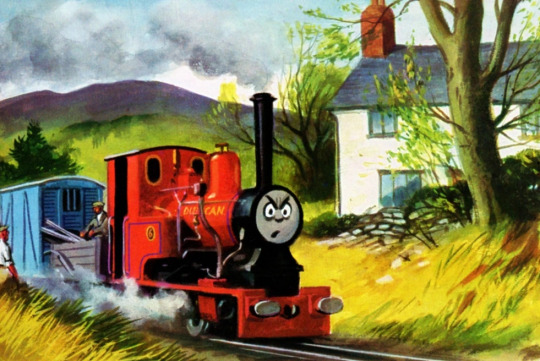
Duncan, as he will happily admit himself, is a plain blunt engine who will rock and roll, and who speaks as he finds.
Sure, he means well, and he’ll pull just about anything… But Rheneas hears the story of him stopping on the viaduct, and is immediately wary of Duncan.
It doesn’t help that, having had the serious responsibility of being the only working engine on the line for an extended period of time, Rheneas has a bit of complex about doing everything himself and see’s anything that happens on the railway as, at least partially, his responsibility.
So Duncan just fully blowing off his responsibility to his passengers and stopping in the middle of the line, something which Rheneas did only once and very much against his best efforts, just feels like a personal insult to Rheneas.
It doesn’t quite register with him that Skarloey has already given Duncan the whole lecture on why that was stupid and how passengers are important.
And Duncan has improved since then. He acknowledges the importance of looking after his passengers and knows to at least keep his complaints out of earshot of them.
The thing is, Duncan is still a plain blunt engine, and passenger etiquette does not come naturally to him. But he’s trying, and quite frankly some of the passengers' complaints just seem ridiculous to him. So what if he rocks and rolls a bit? That's just how he is, and he still gets them to the station on time… usually.
But when Rheneas hears Duncan one night in the shed complaining about a particularly rough journey where there were significant delays and the passengers were really pushing his limits, Rheneas decides that Duncan still hasn’t learned their ways.
Rheneas may also be having a bit of a crisis of questioning just how much the railway still needs him with all of the new engines who are also there now. And what better way to reassure himself that he's still needed than to position himself as a mentor figure.
Duncan, for his part, does in fact respect Rheneas since Skarloey told him how he had saved the railway, and he wants to get along with the guy…
But that becomes increasingly difficult to do when Duncan keep having moments where he’s shunting the yard, minding his own business and doing a pretty alright job… and then he look towards the sheds and see Rheneas watching him like a hawk, looking for any sign that he’s about to mess up somehow.
And on the occasions that Duncan does mess up, however slight, Rheneas is very quick to give his input on what he did wrong and how the whole situation could have been avoided.
Skarloey may be stern, but he at least acknowledges that Duncan is trying his best, and gives him credit when he does well. He at least gives Duncan the respect of treating him like a capable engine.
So Duncan gets along fine with Skarloey… But Rheneas?
Respect him and his efforts to keep the railway running… Sure.
Actually get along with him… Not so much.
This pretty much sums up the dynamic between the two of them.
Until one day…
Duncan is taking the morning train, and one passenger in particular is just being a complete pain in the ass. It’s not just Duncan who’s fed up with him by the time they leave the station, this guy is getting on everyone’s nerves.
But Duncan puts forward his best effort, and maintains his professionalism.
But the guy keeps being a jerk throughout the entire run up the line. Anything goes slightly wrong, and he’s making his grievances known.
Duncan is glad when he doesn’t see him on the platform when he begins the journey back down the line, the man having decided to hike one of the various trails around Skarloey Lake.
When he gets back to Crovan’s Gate, Duncan immediately rolls off to the sheds and starts venting to whoever will listen about the angry passenger.
And right on cue, Rheneas begins his lecture.
Duncan, by this point, has been having a really bad day, and is quite frankly beyond his normal limits. So he just says “Alright then… You know how to deal with passengers, you take the afternoon train”.
So Rheneas does, and all goes well on the up journey. But then he finds Duncan’s passenger at the top station, who is apparently furious that Duncan’s train didn’t wait for him as he went wandering around the lake.
Rheneas tries to point out, very calmly, that there are schedules posted very clearly at every station building, but the man doesn’t listen.
Ok… This is fine.
Rheneas has dealt with his fair share of difficult passengers before, all of them with grace. He can handle this one.
But the journey back down the line doesn’t go smoothly, and all the while the angry passenger is becoming more and more unbearable.
And then, between Glennock and Cros-ny-Cuirn, Rheneas derails.
It wasn’t a particularly bad derailment, and it wasn’t his fault. Just a bad joint in the rails which Rusty and Mr Hugh hadn’t had the chance to fix on their last maintenance run, and which had been worsened by the last few times a train had run over it.
Naturally, the angry passenger is complaining more than ever now, and Rheneas is feeling rather defeated.
It’s Duncan who comes to rescue the train, and Rheneas is surprised but very grateful for the fact that he doesn’t say anything as Rheneas is leavered back onto the rails.
It’s a pretty speedy rerailing too.
Duncan is coupled on infront and the two engines double-head the train the rest of the way home. They get there with no further issues, and most of the passengers are just happy the derailment was sorted out quickly and efficiently, and that they were still able to catch the connecting train.
All except one.
The angry passenger is now just being insulting. Everyone is tired and unhappy, and now they still have to deal with him ranting about what a bad railway this is.
And then Duncan just snaps.
Rheneas never thought he would be happy to hear someone cursing out a passenger…
But Duncan’s tirade in Rheneas’, his own, and the railways defense, is just about the most cathartic thing he’s ever experienced.
Duncan only fully stops after the Thin Controller gets involved, denies the passenger a refund, and watches him storm off out of the station to catch a bus (he had spent so long arguing he had missed the connecting train).
After that, and with one final uttering of good riddance, the two engines shunt the coaches away and go to the sheds for a well deserved rest.
Rheneas see’s Duncan in a new light after that. He still often disagrees with his more grumpy and blunt approach, but he’s finally giving Duncan some space to make mistakes without needless criticism.
Rheneas still insists on the importance of passengers, and treats all of them with respect and high regard…
But he and Duncan have come to an agreement that some of them are just nuisances.
#ttte#rws#ttte headcanon#rws headcanon#skarloey railway#ttte rheneas#ttte duncan#ttte skarloey#ttte rusty#ttte sir handel#ttte peter sam#I might one day turn the last bit with the angry passenger into a full story#sort of a Duncan and the Grumpy Passenger rewrite I guess#This started as being all about Rheneas#But quickly also became about Duncan#Because Duncan's great#Honestly he's probably my favorite of the Skarloey Railway engines#Quite frankly after a while both Skarloey and Rheneas probably find Duncan's attitude somewhat refreshing#It's very different from the “engines should be seen and not heard” mindset that was most likely prevalent back when they were built.#Sometimes you just need a guy who's willing to say fuck
155 notes
·
View notes
Text
Thanks to my rambling this weekend, I am overflowing with love for an MMO that hasn’t been in development since 2012, because goddamn the worldbuilding for the setting of City of Heroes and City of Villains was just superb.
Do you want an MMO that begins as a pastiche of superhero comics that lovingly, cheekily engages with its source material, building up a cohesive world where the fantastical stuff feels unexpectedly real and grounded in the society, more so than most of the comics it's inspired by? Do you want that, and then to watch it slowly, gently tip its backstory into existential, cosmic horror via genre critique?

I'm in no way kidding! More below the cut.
Well, part one of more, because there's a lot to unpack here.
A lot of new superhero continuities these days treats its central premise as an anomaly. For the most popular example, the MCU treats public knowledge of superheroes as something that started with Captain America in WWII. Before his exploits, the fantastical aspects of the setting were forgotten about and hidden from the world. The DCEU begins similarly with Wonder Woman in WWI, a member of a mythic society forgotten by time.
At first, Earth in City of Heroes seemed to go with a very similar premise, though it predates any of those movies: Superpowers were unknown to the general public until the early 1930s, when some people suddenly began gaining incredible new abilities, and mythical critters not seen since ancient times made themselves known.
But that’s just the basic sales pitch. As you dug into the setting and City of Villains expanded the lore, perspective shifted into something entertainingly stranger.
Everyone knew about Nemesis, the clockwork robot-making mastermind who'd terrorized Paragon City from the early 1930s, just when superheroes were first appearing on the scene. Turns out he was an immortal Prussian nobleman born who first went on an automaton-backed crime spree in 1820s, seemingly died when the British Navy bombarded his headquarters in Malta, then reappeared in the 1860s to supply the Confederate Army with mechanical cavalry until General Sherman shelled his mountaintop base on his march to North Carolina. Nobody was ever able to replicate what the did, and with his (apparent) death, he was no longer relevant after 1865. As of the 1930s, anyone who wasn’t a history buff had forgotten about him.
And sure, everyone knew there was an underground city of evil wizards, dead for long eons until they rose again to take human sacrifices from the surface world of Rhode Island (I’m still not over that). But actually, they were active in London during the Victorian mysticism craze, then moved their operations back to their homeland of subeterranean Rhode Island with the outbreak of World War I. They made the news across the continent. They got outlawed in multiple countries. They were a big deal, until the war took the attention off of them.
Hell, one of the people who fought all these weirdos was a random teenager who'd just... always been able to teleport and turn invisible, even prior to the '30s. He wasn't even a main character or anything! His parents knew, and tried to convince him to go get training. Teleportation training. Like y'do, with your socially awkward, teleporting kid.
This setting never actually had a mundane world that was unaware of the fantastical. The fantastical was normal. The arrival of superpowers in 1930 wasn’t a hard fork between history as we know it and theirs, or a reveal of some secret world that rational minds had long denied. It was just a dramatic escalation of what had already been happening, that everyone knew about. Armies of the 1800s had to develop anti-robot tactics. Alastair Crowley publicly dissed an actual wizard cult because they were dangerous competition. Parents worried over the mental health of their superpowered teens. That was normal.
The sheer numbers of fantastical events that started happening after 1930 were not normal. Or at least, not at first. People slowly adjusted over decades, as more and more young people grew up in a world that had always been that way.
What nobody realized at that point was how the new normal bordered on a state of cosmic horror.
And that’s where the setting really starts interrogating its inspirations.
#city of heroes#city of villains#my love for this setting is unbounded#and it honestly deserves more attention and analysis for how it engaged with the genre#it ranged from joyously fluffy nonsense to deeply disquieting introspection and all they way back around to hootingly funny bullshit#I definitely have more rambles coming on this because I CANNOT BE STOPPED
30 notes
·
View notes
Note
Serious Q: Which presidents do you think had the most problems with alcohol while in office? You wrote that Nixon was drunk sometimes at the end of his term before resigning, for example. But who do you think had the most consistent problem with the bottle over their presidency?
The only Presidents who are believed to have been alcoholics are Franklin Pierce and George W. Bush, but in both cases, their alcoholism didn't take place while they were in office. Bush famously stopped drinking when he was 40 years old. Pierce was a heavy drinker as a member of Congress, but seemed to have a handle of things while he was President. But things went off the rails for him after he left office and he basically drank himself to death.
Ulysses S. Grant's drinking was sometimes a problem, but it apparently only flared up when he was lonely and stationed far away from his wife. Being stationed in California and Oregon after the Mexican-American War was really difficult for him and his drinking resulted in him basically having to resign his commission and return to civilian life. He fell off the wagon a handful of times during the Civil War, but it didn't incapacitate him as it had on the West Coast, and he didn't seem to have any issues with alcohol while he was President.
Nixon's drinking was probably the most concerning, but not because it happened constantly. Nixon was a notorious lightweight when it came to drinking, and he would get drunk very easily. The major issue with Nixon is his temperament, combined with intoxication, especially when things were going really badly with Watergate. There were serious worries from people within the Nixon Administration about what Nixon might do or orders he might give while drunk, particularly in the last weeks of his Presidency.
I think the other person worth mentioning is Andrew Johnson. There is some debate about whether or not Andrew Johnson was an alcoholic or even a heavy drinker. He had an infamous incident at his inauguration as Vice President in 1865 when he was apparently not feeling well and decided to have a couple of stiff drinks to get through the inaugural ceremonies. But those drinks were a little too stiff, and he launched into a rambling and insulting speech to Congress after he took the Vice Presidential oath. Johnson is one of the more obscure Presidents, so there's not as much definitive information about his life and career as, say, Ulysses S. Grant. Johnson was also abrasive and widely disliked by his colleagues, so it's know how true the memories of many of his contemporary sources were. But there are many, many examples of Johnson -- both before and during his Presidency -- making speeches where he was abusive and threatening to the audience and when speaking about his many political opponents. I think it's probably likely that alcohol played a part in some of those wild speeches and his behavior in public, but I can't prove it.
Other than that, it seems most of our Presidents who drank -- even those who drank more heavily than others -- had pretty good tolerance for their alcohol and didn't allow it to affect their job performance during their Presidencies. Some of these guys were pretty hardy dudes -- I mean, John Adams started smoking when he was 8 years old and was said to drink hard cider for breakfast and lived until he was 90 years old (in the early 19th century!) -- so most of them could handle their shit.
#Presidents#History#Presidential History#Drinking#Presidential Drinking#Presidential Personalities#Richard Nixon#President Nixon#Andrew Johnson#President Johnson#John Adams#President Adams#Franklin Pierce#President Pierce#George W. Bush#President Bush#Bush 43#Ulysses S. Grant#President Grant#General Grant#Vice Presidential Inauguration of Andrew Johnson#1865 Inauguration
17 notes
·
View notes
Text
Catching up with Les Mis Letters and as always fixating on the small references to the fashion of the time. This time I was left wondering how the "Marius wore crape on his hat" would look like, I couldn't find something from the 1830s but here's some examples from later in the century, I expect it would look kind of similar.
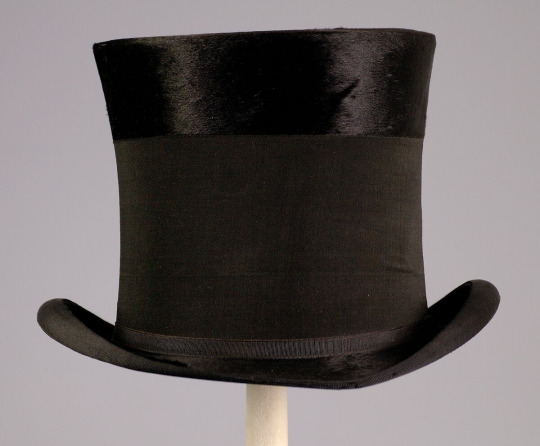

Mourning top hat, American, 1890. Brooklyn Museum Costume Collection at The Metropolitan Museum of Art. (x)
Gentleman Mourner with crape on his hat, c.1865 (x)
Apparently, the wider the crêpe band, the deeper the mourning/the closer the loss, the band it's supposed to cover the shiny silk of the hat (less ornament/less flashy). And here a quote, also from later in the century, but oh well:
"The mourning-dress usually worn by a gentleman is a full suit of black broad cloth, a crape band round the hat, of depth governed by the closeness of the black worn, and jet studs and cuff buttons. A widower wears a band the width of his hat, and this is the deepest mourning worn. The fashion, prevalent we know, of wearing only the crape hat-band for mourning, and the rest of the dress of the usual light or dark colors has the advantages only of convenience and economy, but is making a farce of mourning [...]". (The Art of Dressing Well, 1870, p. 144-5) (x) (x)
36 notes
·
View notes
Text
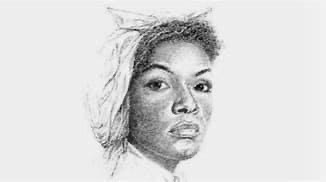
Meet Mary. She was Free, Educated and A Spy. Her Disguise… Confederate European House Slave!
Mary was the best as she was working right in The Confederate President’s home. She had a photographic mind. Everything Mary saw on the Rebel President’s desk, she could repeat word for word.
"Ellen Bond" was neither dim-witted, illiterate, nor a slave. In reality, she was a free, well-educated African-American woman by the name of Mary Elizabeth Bowser. And she was a Union spy working right under Confederate President Jefferson Davis’s nose.
For months during the most crucial period of the Civil War, as General Ulysses S. Grant maneuvered to capture Richmond, the Confederate capital, Mary supplied critical military intelligence to the Union army. In recognition of her contributions to the Union war effort, she was inducted into the U.S. Army Military Intelligence Hall of Fame in 1995.
Elizabeth was able to arrange for a friend to take Mary with her as a servant to help at social functions held by Varina Davis in the Confederate White House. Mary performed her servant role so well she was eventually taken on full time as, presumably, a slave hired out by her master.

As a spy, Mary enjoyed a significant advantage: invisibility. It’s not that she was unseeable, like H. G. Wells’ Invisible Man, but rather that as a black slave, she was unseen and unnoticed by the whites she served. Her entrance into the dining room to serve at table in no way affected the conversations Jefferson Davis might be having with visiting generals. When she went to his office to clean, it did not occur to the Confederate president that this seemingly ignorant and dull-witted African woman could have either the capacity or the interest to glean information from the papers he left lying on his desk.
In fact, Mary’s role went far beyond the norm. Whatever she read or heard she was able to remember and pass on word-for-word. That’s the testimony of Thomas McNiven, the official head of the Richmond spy ring. McNiven ran a bakery and made daily deliveries all around the city, including to the Confederate White House. This allowed Mary to regularly meet with him for a few minutes as he delivered his goods to the Davis household. Years later, in 1904, McNiven recalled those days to his daughter and her husband, who eventually recorded his story:
Mary was able to continue her espionage activities until January of 1865. Jefferson Davis had become aware that information was somehow being leaked, and suspicion apparently began to fall on Mary. She made the decision to flee Richmond and seems to have made her way to the North. One unsubstantiated account says that in her last act as a Union agent, she tried to burn down the Confederate White House, but was unsuccessful.
Sometime in the early 1850s, Mary was sent to Philadelphia, as Elizabeth had been, to be educated at a Quaker school for African Americans. In 1855, with Mary’s schooling complete, Elizabeth arranged for her to join a missionary community in Liberia. Mary, however, hated living in the African country, and by the spring of 1860 was back in Richmond with Elizabeth.
A year later, in April 1861, Mary was married to Wilson Bowser, a free African man. Interestingly, the ceremony, like her baptism, took place at St. John’s Episcopal. The wedding notice listed both Mary and Wilson as “colored servants to Mrs. E. L. Van Lew” (Elizabeth’s mother).
262 notes
·
View notes
Photo

Today is my birthday and I’d like to pay tribute to my maternal great-grandmother. This photo was taken in 1955, and she died shortly thereafter so I never knew her.
My great-grandmother was born in 1860 and slavery was abolished in North Carolina in 1865. So yes, she came into the world and spent her early childhood as a slave.
I have few regrets in life, but one of them is definitely not paying closer attention to the stories my grandmother told me when I was a little girl about her mother, or to the stories my mother told me about her grandmother. And with my grandmother and my mother both gone, all I have is a photo — which is not in the best condition — and my limited recollection of the stories I was told.
The purpose of this post isn’t to recall these stories, but simply to honor a woman who worked harder than I can imagine most of her life to take care of her family, but who apparently also knew how to laugh and have a good time . . . Could she be singing in the photo?
I am proud to be her great-granddaughter.
75 notes
·
View notes
Text
HISTORY THAT SHOULDN'T BE FORGOTTEN.
Jefferson Davis was never tried for treason. He was imprisoned for 2 years without a trial, however...
The post-war Jefferson Davis: The famous trial that never was.
By Bill Ward
When the War Between the States ended, the victorious Northerners viewed Jefferson Davis, as the former President of the Confederate States of America, much differently than others who had served the Confederacy.
For example, when Robert E. Lee surrendered to U.S. Grant at Appomattox Court House, the meeting between the two generals was amicable. Lee was received and treated with courtesy as a senior officer. The terms were so apparently lenient, with Grant conceding to Lee’s requests on behalf of his soldiers, the surrender was referred to as “a gentleman’s agreement.”
However, even after signing a loyalty oath, Lee and other former Confederate Army officers and members of the CSA government were later disenfranchised and treated as second-class citizens. But in the eyes of the northern public, Jefferson Davis was set apart for still a different kind of treatment.
On May 10, 1865, about a mile from the town of Irwinville, Georgia, Federal troops captured Davis. With his arrest on that spring morning, his government ceased to exist. His wife, Varina, and their children were sent to Savannah, where she was kept under virtual house arrest and forbidden to leave the city. Because the soldiers, carpetbaggers and Union supporters treated the Davis children so badly, Varina arranged for them to go to Canada along with her mother.
Davis had been taken back to Virginia and imprisoned in Fort Monroe, where he would stay for the next two years. At first, he was bound in leg irons. Guards watched him around the clock but were not permitted to speak to him. He was allowed no visitors; a light burned in his cell day and night; and his only reading material was a Bible. His treatment was a clear violation of the Bill of Rights.
Many Northern Congressmen and newspapers were nothing short of vicious in their public attacks of Davis. They wanted to see him tried for treason and hanged. In one article, and in one very long sentence, the New York Times referred to Davis by every insulting comment and offensive name that was fit to print. Rhetoric far outran legal reasoning.
But if Davis was in an unusual legal predicament, so was the United States government. The dilemma faced by Washington was how to handle the Davis case. The government under Lincoln had created its own major obstacles by spending four years proclaiming that secessionists were “traitors and conspirators.” The U.S. military had silenced opposition to the administration by closing down newspapers that dared challenge the party line or to make the slightest suggestion that secession might be legal. Thousands of Northerners had been jailed for exercising their First Amendment rights, and those thousands had friends with long memories in the Northern bar.
Northern lawyers were angry for having their clients locked in prison with no civil rights as guaranteed by the Constitution; having civilians tried by military courts for non-existent crimes; having a government that ignored the Supreme Court, setting itself above the constitutional plan of checks and balances. They didn’t like having to beg the president for justice for clients convicted by phony courts-martial or locked up for long periods without any trial. Under Lincoln, the U.S. government had become tyrannical, and certainly anything but a free and constitutional society.
The best lawyers of the day were willing to volunteer to defend Jefferson Davis, because they were angry at the way Lincoln’s government had trampled the Bill of Rights and the Constitution for four years. Even those who didn’t believe in secession were repulsed by the conduct of the Republican administration and the U.S. military.
Charles O’Connor of New York, one of the most famous trial lawyers of the era and a man of great stature in the legal profession, volunteered to be Davis’s counsel. Salmon P. Chase, Chief Justice of the Supreme Court, would be the trial judge.
But interesting things began to happen, and the government’s dilemma became even worse. University of Virginia Law Professor, Albert Bledsoe, published a book, “Is Davis a Traitor?” Bledsoe methodically took apart the case against secession, delivering a solid blow to the prosecutors and dampening their zeal to try Davis. Prosecutors actually began to look for a way to avoid trying him without vindicating the South.
Then another method was decided on for prosecution. The attorney general would bring in outside, independent counsel, as we have seen in modern times, such as in Watergate or the Clinton scandals. The government needed someone of great standing in the legal community to be the lead prosecutor. It chose John J. Clifford. But after reviewing the case, Clifford withdrew citing “grave doubts” about the validity of the case. The government could “end up having fought a successful war, only to have it declared unlawful by a Virginia jury,” where Davis’s “crime” was alleged to have been committed.
President Johnson, Lincoln’s successor, thought the easiest way out would be to pardon Davis, as he had pardoned many other Confederates. But Davis refused, saying, “To ask for a pardon would be a confession of guilt.” He wanted a trial to have the issue of secession decided by a court of law — where it should have been decided to begin with — instead of on battlefields. Most Southerners wanted the same.
Northerners either forgot or were unaware of a great secessionist tradition in America. Southerners were not alone in their view that each state had the right to determine its own destiny in the Union. The procedure for joining the Union also applied to withdrawing from the Union.
That thought harkens back to an editorial by the Cincinnati (Ohio) Daily Inquirer, in the summer of 1861, after the “traitor” label was let loose by the North: “The Republican papers are great on treason. . . . It is treason to circulate petitions for a compromise or peaceful readjustment of our national troubles . . . to question the constitutional powers of the President to increase the standing army without authority of law . . . to object to squads of military visiting private houses, and to make search and seizures. . . to question the infallibility of the President, and treason not to concur with him. . . It is treason to talk of hard times; to say that the war might have been avoided. It is treason to be truthful and faithful to the Constitution.”
A year after John Clifford withdrew, the government appointed another special counsel, Richard Dana of Boston, who had written the novel, “Two Years Before the Mast.” But after reviewing the evidence, he agreed with Clifford; the case was a loser. Dana argued that “a conviction will settle nothing in law or national practice not now settled…as a rule of law by war.” Dana observed that the right to secede from the Union had not been settled by civilized means but by military power and the destruction of much life and property in the South. The North should accept its uncivilized victory, however dirty its hands might be, and not expose the fruits of its carnage to scrutiny by a peaceful court of law.
Now, over two years after Davis’s imprisonment and grand jury indictments for treason, the stage was set for the great public trial of the century. Davis had been released from prison on a $100,000 bond, supported by none other than Horace Greeley, the leading abolitionist writer in the North and a former Lincoln supporter. Greeley and a host of others were outraged at the treatment Davis had received, being locked up in a dungeon for more than two years with no speedy trial.
Since two famous special counsels had told the government its case was a loser, finally, none other than the Chief Justice, in a quirk of Constitutional manipulation, devised an idea to avoid a trial without vindicating the South. His amazing solution was little short of genius.
The Fourteenth Amendment had been adopted, which provided that anyone who had engaged in insurrection against the United States and had at one time taken an oath of allegiance (which Davis had done as a U.S. Senator) could not hold public office. The Bill of Rights prevents double jeopardy, so Davis, who had already been punished once by the Fourteenth Amendment in not being permitted to hold public office, couldn't be tried and punished again for treason.
Chief Justice Salmon P. Chase secretly passed along his clever argument to Davis’s counsel, Charles O’Connor, who then made the motion to dismiss. The Court took the motion under consideration, passing the matter on to the Supreme Court for determination.
In late December 1867 while the motion was pending, President Johnson granted amnesty to everyone in the South, including Davis. But the Davis case was still on the docket. In February 1868, at a dinner party attended by the Chief Justice and a government attorney, they agreed that on the following day a motion for non-prosecution would be made that would dismiss the case. A guest overheard the conversation and reported what was on the minds of most Southerners: “I did not consider that he [Davis] was any more guilty of treason than I was, and that a trial should be insisted upon, which could properly only result in a complete vindication of our cause, and of the action of the many thousands who had fought and of the many thousands who had died for what they felt to be right.”
And so, the case of United States versus Jefferson Davis came to its end — a case that was to be the trial of the century, a great state trial, perhaps the most significant trial in the history of the nation — that never was.
8 notes
·
View notes
Text
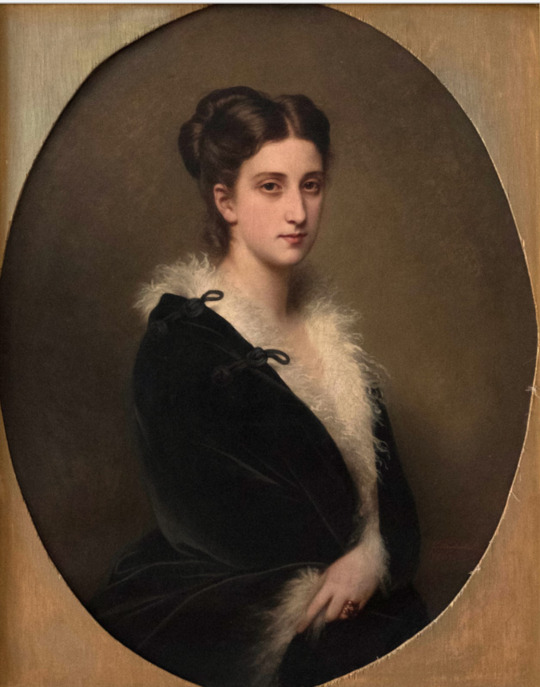
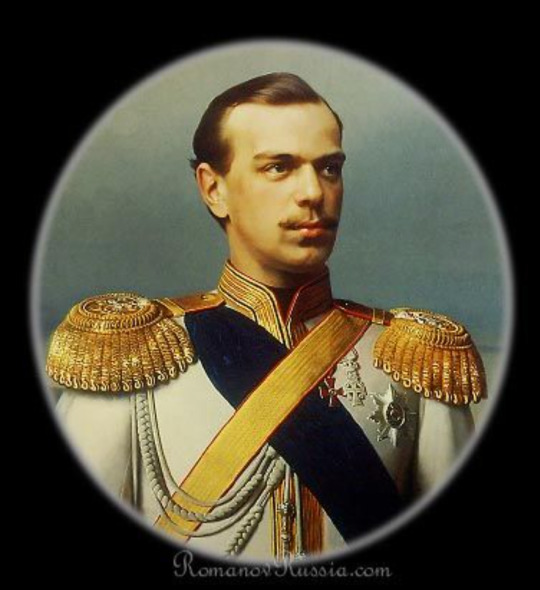
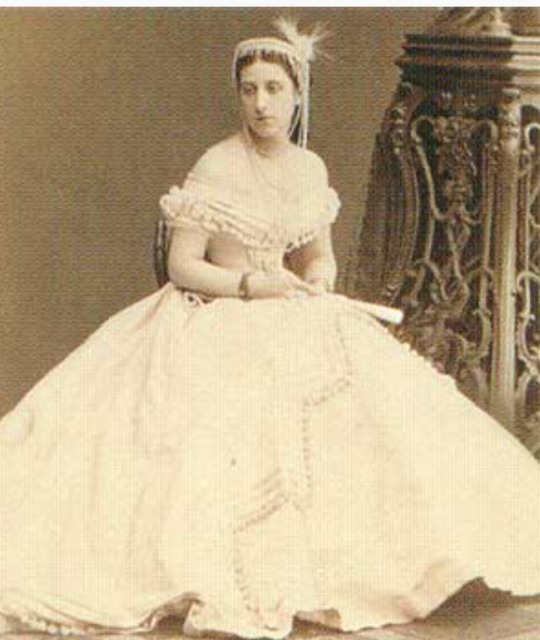





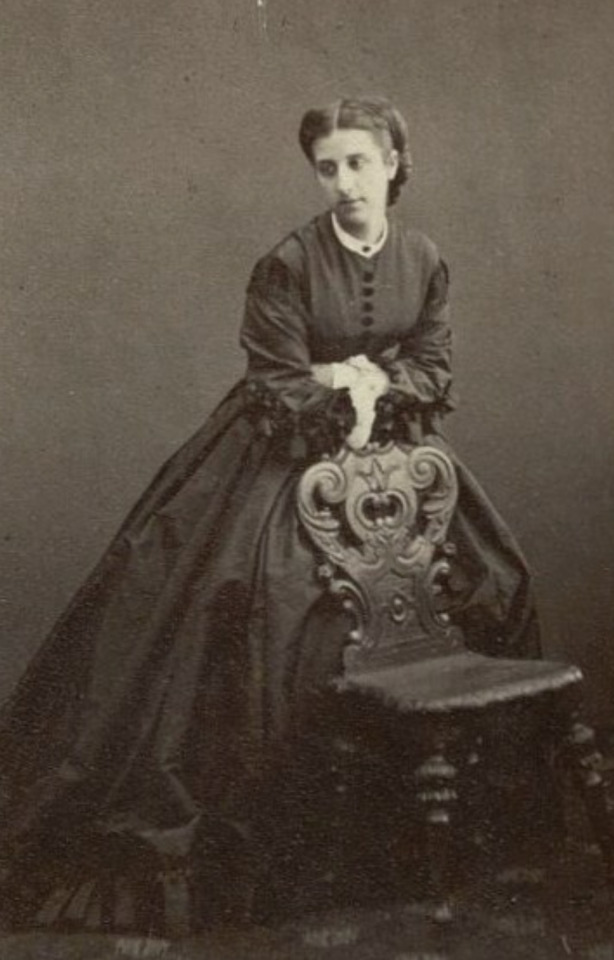

Photographs: 1. Portrait of Princess Maria Elimovna Meshcherskaya; 2. Miniature of young Tsarevich Alexander Alexandrovich; 3. Sasha; 4. Maria; 5. Another beautiful photograph of Maria; 6. Maria with her aunt; 7. Maria on horseback in a riding outfit; 8. Another photo of Maria; 9. Maria and her husband, Paul Demidov (often spelled Demidoff), Prince of San Donato (apparently, the marriage was not arranged).
Alexander III's first love (it was not Dagmar)
The portrait of Alexander III that has come down to us through history is undoubtedly flat. It tells us that he was a good, faithful husband, a devoted father, and a champion of autocracy. Yes, he had a temper; no, he did not like to dance; he preferred to drink with the boys. He was respected enough by his family that he could keep it in order. Unfortunately, he died too young.
His diaries at the State Archives of the Russian Federation tell a different story. I don't know if the diaries are complete. Authorities found three missing notebooks in 2015. Here and there, you can find comments by authors and scholars alluding to the fact that his entries show a degree of emotional depth that surprises all. It is through these diaries that we learn about Sasha's first love, Princess Maria Elimovna Meshcherskaya (1844-1868), daughter of Prince Elim Petrovich Meschersky (1808-1844), Chamberlain of the Imperial Court and a poet; her life was quite short and tragic.
According to those who knew her (such as Count Serge D. Sheremetiev and Countess Kleinmichel), she was one of the prettiest young women in St. Petersburg. She had brown hair and large black eyes. The young woman was an orphan from an early age, and her aunt Princess Baryatinskaya brought her up. One source says she met young Grand Duke Alexander at a costume ball (she looked stunning in an Egyptian costume.) Regardless, they often met at Court, as the princess was Maid of Honour to Empress Maria Alexandrovna, and they fell in love. At that time, Alexander was not Heir to the throne and might have harbored hopes to marry her. But, in 1865, his beloved brother, Tsarevich Nicholas, died, and with his death, all possibilities of Alexander marrying Maria disappeared. As Tsarevich and future Emperor of Russia, Alexander knew he had to marry someone of royal blood.
Alexander's brother Nicholas had been engaged to young Princess Dagmar of Denmark. For political reasons, both royal houses still wanted an alliance between them to take place. A trip to Denmark was planned for the new Tsarevich only a few months after Nicholas's death. Sacha understood what this meant. A plan to have him marry his brother's fiance was afoot. He felt torn between his duty to his father and country and his love for Maria Meshcherskaya. He also felt unprepared to become Emperor and thought of renouncing his position as Heir, which would leave him free to marry Maria. He tried to avoid seeing her. On June 25, 1865, he wrote in his diary that this was difficult as they used to see each other twice daily. However, he was thinking more and more about Dagmar and felt the need to have a wife (meaning Dagmar). But soon, his determination wavered; he continued to see Maria, and his love for her deepened through the summer and autumn of 1865. On March 23, 1866, however, he wrote in his journal, "I will say goodbye to M.E., whom I loved as I have loved no one before."
But two months later, he, once more, had a change of heart. As a trip to Denmark was imminent, he wrote, "I grew to love her (M.E.) even more fervently, strongly, passionately. Now I am only trying to escape this difficult situation and, if possible, to marry sweet M.E. I want to refuse to marry Dagmar, whom I cannot and don't want to love." When Alexander II confronted his son with stories about him and Maria Mescherskaya (a story had made it to the Danish papers about the Tsarevich not wanting to marry their princess because of his affection for another woman), the Tsarevich answered that he could not go to Denmark and did not want to marry Dagmar. The Emperor gave him 24 hours to reconsider. The next day Alexander II again asked his son about the Danish wedding: Sasha replied that he did not feel he could love Dagmar and added that he had decided to renounce his position as Heir because he did not feel he could do a proper job. Alexander II got quite angry, talked about duty, and ordered his son to go to Denmark, adding he would send Princess Mescherskaya away. Alexander obeyed his father, went to Copenhagen, and proposed to Princess Dagmar. And as they say, the rest is history. The marriage of two people who had started loving others (Dagmar had loved Nixa, and Alexander had loved Maria.) turned out to be very loving and successful.
Alexander II did ask Princess Mescherskaya to leave Court immediately. Young Sasha had pleaded with his mother that the young woman not be punished. She went abroad with her aunt and settled in Paris, where she met a Russian diplomat, Paul Demidov (often spelled Demidoff), Prince of San Donato, and married him. Demidov was one of the most eligible bachelors of his time, having inherited one of the largest fortunes in Russia! The couple lived abroad. Sadly enough, Maria died in 1868 after giving birth to a son she would not live to see grow up. Her husband, who later married again, grieved her death long and deeply. (gcl)
#Alexander III#Alexander II#Princess Dagmar of Denmark#Empress Maria Feodorovna#Empress Maria Alexandrovna#Princess Maria Mescherskaya#Paul Demidov#imperial russia#romanov dynasty
14 notes
·
View notes
Text
I'm out for Lent so here's a previously scheduled Fun Fact Friday post!
We’re wrapping up Black History Month, so Today You Learned about Bass Reeves (who, contrary to folk belief probably did not inspire the Lone Ranger, but is still a really cool dude).

Bass Reeves was the first black deputy US Marshal west of the Mississippi and was widely known as a complete badass. He made over THREE THOUSAND arrests. Reeves was born in slavery, but escaped during the American Civil War and hung out in Indian Territory until he was freed by the Thirteenth Amendment in 1865.
Now in 1875 when a US Marshal was set over the area, said Marshal decided that Reeves, as a guy who knew how to handle himself, was familiar with the area, and knew more than one Native American language, was the perfect guy to be in law enforcement.
Look, guys, this man was a Beast. A skilled marksman, detective, and polyglot, who like said brought in thousands of criminals. And he’s only killed fourteen. Considering how prolific of a lawman he was, it’s impressive how rarely he killed, in my opinion. Reeves even one time arrested his son for murder, which clearly disturbed him but he knew his duty.
[Said son was convicted, did his time, and apparently lived the straight and narrow afterward, in case you were curious.]
At one point Bass Reeves was tried for murder, but he claimed he was cleaning his gun and it went off. Reeves was acquitted.
He eventually retired in the early 1900’s and died shortly afterward. One wonders if the stress of everything had a negative effect on his health.
The man’s been portrayed in several different pieces of fiction–Timeless features him in an episode, as does Legends of Tomorrow, and he’s one of the characters in the Netflix original film The Harder They Fall (pictured below).

Also, he has a Badass of the Week article.
26 notes
·
View notes
Text
My math isn’t mathing, I had an idea for a AWAE fic, the oc would be a person of colour, and originally they were going to be the child of Bash (had them at a young age.) I searched that bash was born in 1877, and apparently season 2 is set in 1897 which my calculator says would make Bash 20 (I always thought he’d be in his 30s) and season 3 is apparently in 1899, meaning bash was 22 or something when Delphi was born, Mary around 30 am I correct? (Wiki saying she’s born in 1865) like, if I were to write this, would it be possible to age up bash or would that throw a lot of things off?
(The oc would be 13-16)
#awae#anne with an e#awae spoilers#awae s3#Sebastian Locroix#Mary Locroix#anne shirley#gilbert blythe
2 notes
·
View notes
Note
Something I was thinking about, but do the bios for Lucille and Thomas hint anything for their parents ages? I've always thought that Lady Sharpe's portrait looked rather "old" because she looks like she could be my 80 year old grandmother in the picture, but we know Thomas and Lucille were only 12 and 14 when she died (with Baronet Sharpe dying before that iirc)... Do you think the Sharpe parents were just much older than most when they had their children? Like for comparison, Mr. Cushing is only turning 60 but Edith is in her early 20s, and he looks much younger than Lady Sharpe. I guess Lady Sharpe could also be aged from the stress of an abusive husband... There's also the doylist idea that somebody fucked up somewhere. What do you think?
The bios say that Beatrice married James (the Parents Sharpe) when she was 30 in 1860, so someone definitely fucked up. Because that would make her 49 when Lucille murdered her in 1879, and even truly NUCLEAR stress aging couldn’t make her look like the portrait at that point.
But to be fair, the bio math is all sorts of weird given canon: Lucille and Thomas are said to be 32 and 30 respectively, but Thomas’ birth year is later than Edith’s. Carter’s father is mentioned as having fought in the American Civil War during Carter’s childhood, but if Carter would have turned 60 in 1901, he was born in 1841 and thus already in his 20s during the war.
Mostly I take birthdates from the bios and scrap years/stated ages if they contradict the actual movie. The newspaper clipping says Beatrice was killed in 1879, when her children were 14 and 12? Cool, well, per Carter’s checkbook it is 1901, so now they’re 36 and 34 and were therefore born in 1865 and 1867 respectively. And so on.
In keeping with that, I tend to assume that Beatrice was like…IMMEDIATELY pre-menopausal when she had Thomas. Like. 49. Plus 12 equals 61 when she died, and at that point, the stress could well have made a crone of her (as you say). James was canonically quite handsome despite his monstrosity- apparently the siblings take after him physically; Beatrice was blonde before she went gray -but nothing is said about his age. He died in August of 1876, though, per the news clipping- when Lucille was 11. Babby’s First Murder. Though in fairness, he HAD almost choked Thomas to death just beforehand.
(Fun fact: Eleanor was 18 when she married Carter. She had several miscarriages before Edith, but that still means she was likely only in her early 30s when she died. Ouch.)
37 notes
·
View notes
Text
The Winterhalter That Wasn't: The Real Authorship of a Portrait of Queen Marie Sophie of the Two Sicilies

Oh, Franz Xaver Winterhalter: THE painter of royals. Born in 1805, the German painter made a career by painting detailed, gorgeous, romantic and flattering-yet-still-accurate portraits through out the courts of Europe. Amongst his royal sitters were Queen Victoria, Empress Eugénie of the French, Empress Maria Alexandrovna of Russia, Queen Isabel II of Spain, Empress Elisabeth of Austria, and many more. Everybody wanted to be painted by Winterhalter, and the painter was in high demand until the end of his life in 1873.
Winterhalter is my favorite portraitist. The sheer amount of detail that he put into the fabrics of the dresses is impressive, as it is the way he enhanced his female sitters and romanticized them while still making them recognizible (non of his male portraits are that impressive, sorry guys).

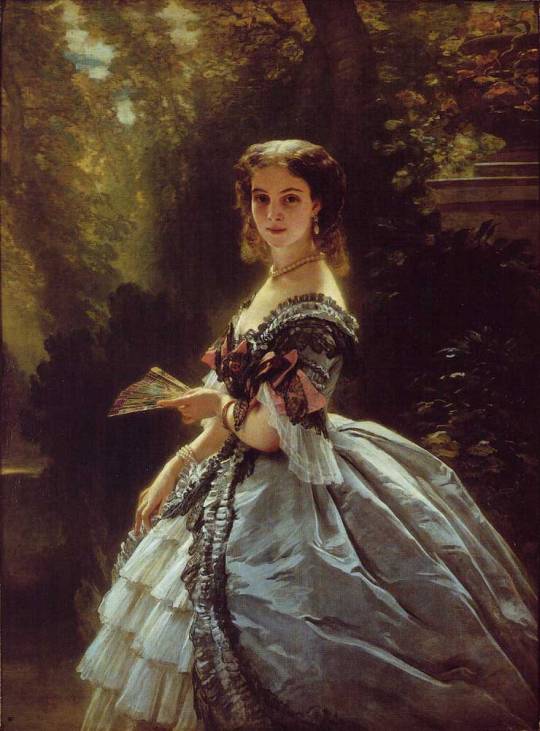

Queen Marie Henriette of the Belgians (1865) // Princess Elizaveta Esperovna Troubetzkaya (1859) // Empress Eugénie surrended by her ladies in waiting (1855). All by Franz Xaver Winterhalter.
So remember how Winterhalter painted Empress Elisabeth of Austria? Well, he also painted her younger sister Marie, the last Queen of the Two Sicilies. Possibly. Maybe. Allegedly. I actually haven't found any evidence of this, but I did read people talking about it on royal discussion forums, and the people there absolutely knows what they are talking about. So it is possible.
Now enters the portrait that compels this post: the alleged portrait of the Queen of the Two Sicilies by Franz Xaver Winterhalter.

Queen Maria Sophia of Naples, attributed to Franz Xaver Winterhalter
So what do we know of this portrait? Not much that I could find. It is listed in Wikimedia Commons as belonging to the Minneapolis Institute of Art, and that it was a "Bequest of the Estate of Miss Marguerite Davis", whom apparently was like a super rich lady from the mid 1900. And as I said before, it has been attributed to Winterhalter.
If you google it you will find it as such in plenty websites and social media posts. But not gonna lie, I always thought that this identification was fishy. Look at the portraits I shared above and then look at this portrait. Does it really look like it was painted by the same guy? The guy known for his detailed idealized portraits? Like were are the textures of the fabrics? The more I looked at the portrait the less it looked like a Winterhalter.
Yesterday I was looking for information for a new post about Marie that I'm writing (also relating an artist) when I came across an article by Anne Brewster called "American Artists in Rome", published in the February 1869 edition of Lippincott's Magazine of Literature, Science and Education. The article, written from Piazza di Spagna in December 1868, had a mention of Marie so of course I had to read it. In it Brewster paints a picture of Rome and its residents from the United States. It was the beginning of the season and artists were filling up the studios; she visited two of them, an sculptor's and a painter's. First the studio of Mr. Mozier, in which she found many of his works such as "Undine" and "Lady of Avenel". Then she moves onto Mr. Buchanan Reid's studio, "at present one of the most attractive in Rome." The main attraction of it, Brewster tells us, is his new portrait of the ex-queen.
You cannot imagine the way my heartbeat raised as she described the portrait and I realized that I freaking knew what she was talking about:
But the principal object of interest just now at Mr. Read’s studio is his unfinished portrait of Maria Sofia, ex-Queen of Naples. Mr. Read has been closely engaged for two weeks at the Farnese Palace, where this beautiful young throneless queen has been sitting to our famous poet-painter, and his subject has inspired him to create a lyric in his picture.
Enough of the portrait is finished to enable us to read the poetic thought. In the background is Vesuvius and a sunset. The sky is beginning to be dotted with stars. The head of the Bavarian Bourbon queen wears no diadem but her own superb hair, which lies in a high mass of ruddy chestnut hue, and in the sky just above this true regal crown of beautiful womanhood is the evening Star.
The ex-queen’s face has tragic points in it, and in some photographs she looks as if she might be a bandit’s wife as well as a Bourbon princess; but Mr. Read has caught these striking features and rather fierce expressions, and with the transmuting power of a poet and artist blended them into deep feeling and thrilling emotion. Her hand is playing with the pearl necklace that encircles her throat, while from the fingers the pendant cross has slipped and rests against the light, filmy drapery of the breast.
The fire in the flashing eyes of the queen is softened down almost into tenderness, and there beams from them a look of something like faith and trust in the future—a watching for the rising of the morning planet.
While looking at the picture we feel so impressed by its expectant expression that we cannot help recalling how many marvelous changes crowned heads have had in our memory, and imagination willingly restores this young Bavarian girl to the throne that slipped away from her just as she stepped upon it as a bride.
I actually yelled "I KNEW IT" when I read this. Here I had my confirmation: that portrait was NOT a Winterhalter. Since the portrait as we know it today looks exactly as it is described by Brewster it seems that Mr. Read never finished it. But who was Mr. Read?
Thomas Buchanan Read was a poet and painter born in Chester, a county of Pennsylvania in 1822. When he was 10 years old he was apprenticed to a tailor, but he ran away to Philadelphia and got a job as a clerck on a grocery store, rolling cigars and painting business signs. After a bunch of comings and goings in which he discovered his abbility for art, at age 18 he met the wealthy Nicholas Longworth, who opened a studio for him. Thus began his career as a painter, which gained him praise. His career as a poet seems to have been much more prolific and praised, with several publications that span for over twenty years. He went to Europe for the first time in 1850, and then again in 1853 until 1858, where he dedicated to the study of art in Florence and Rome. During the American Civil War Read he was a major in the Union Army, but because his weak physical prevented him from joining the battle he put all his strenght in lifting up the morale and recruiting soldiers by giving public readings and reciting his war poems in the camps of the army. He spent his time between Philadelphia and Cincinnati, but during the final years of his life he lived mainly in Rome. In 1872, when he was sailing back to the United States with his family, he caught pneumonia, and by the time they reached New York City he was too weak to continue traveling. He died a week later on May 11 1872 aged 50 years old.
Here are some paintings by Buchanan Read:

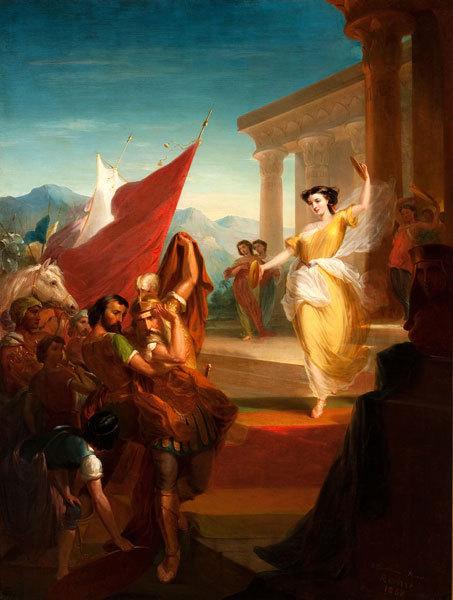

The Harp of Erin (1867) // Jepthah's Daughter (1858) // The Angel Appearing before the Shepherds (1870)
Look at the textures! Look at the colors! Comparing these portraits to Marie's I can say "yeah this was painted by the same guy". Also his thing absolutely was "lady in a translucid white dress", so maybe the portrait is just meant to look Like That.
Last night I was excited about my discovery, but now I'm a bit sad. Read's portrait of Marie is beautiful and memorable, and yet it has been misslabeled as a Winterhalter for years. He deserves the proper credit for his work. I will try to write to the Minneapolis Institute or Art later to see if they a) still have this portrait in their collection and b) if they will correct its authorship. If you see this portrait going around as a Winterhalter, try to correct it. It's time to give this painting back to his author.
Sources for Read's biography: [x] [x]
#this might be my greatest collaboration to the royal portraits enthusiast community#also one of the articles i cited at the end actually mentions that marie was one of read's sitters!#queen marie sophie of the two sicilies#artist: thomas buchanan read#artist: franz xaver winterhalter#thomas buchanan read#franz xaver winterhalter
46 notes
·
View notes
Text
I did more surface level research on Francis Henderson Sr's family. I did some basics back in March, which you can see here. Something else that is important for later information is the research into the possible descendants of Francis Henderson Jr, which you can find here. With new evidence that's popped up, I think it's even more likely that Francis Henderson Jr possibly had a child.
To start, as far as I'm aware, there seems to only be evidence of four children by Francis Sr and his second wife, Elizabeth. William Hoggan Henderson (1816 - 1897), Elizabeth Hoggan Henderson (d. 1828 aged nine), Janet Henderson Carruthers (1822 - 1856), and Robert James Henderson (c. 1826 - c. 1914).
William married a woman named Mary (1817 - 1906). The couple only had one child, Anna, born 1849 and died 1855 at the age of six.
Janet obviously married due to her surname, but I couldn't find any information regarding her marriage, or if she had any children. It's likely that the marriage was short-lived and childless, as she died at 34 and was buried with her parents.
Robert has the most sources out of all of his siblings (including Francis Jr). Robert married a woman named Haley Russel Salisbury. Apparently, she was born in France. They had at least three children, a daughter named Mary Phillips Henderson, born c. 1862, and another daughter born in 1865 probably named Isabel Henderson. They had another son, William H Henderson, born c. 1869.
I couldn't find any later sources for Mary or Isabel (but to be completely honest, I didn't look too hard), but I found one for William. He married a woman named either named Bertha or Elizabeth and had four children. Mary, born c. 1892, William, born c. 1895, George, born c. 1900, and....Mahala, born 1906.
Now, if you read the research I did on the supposed descendants of Francis Jr, you probably had the same reaction I did, of "Hmm??? Mahala???" While I initially wrote it off as a wild coincidence, when I went back to all of my previous research on Mahala (who, for the uninitiated, was allegedly the only surviving grandchild of Francis Jr), it actually lines up shockingly well. Mahala, her husband Coleman, and their children all moved to Rhode Island sometime between 1898 and 1900. I even pointed out in my post that the fact Mahala and her family decided to go to Rhode Island, where their supposed great-grandfather's family lived, was interesting. And Mahala isn't exactly a common name, even in this time period.
I don't know. It seems pretty likely to me that Mahala got into contact with her maybe-cousins and decided to go live with them. It's obviously just speculation; it could just be a wild coincidence.
I haven't done any further research because I was just eager to share after being gone for apparently eight months.
#Francis Henderson#francis henderson jr#francis henderson sr#historical john laurens#john laurens#frances laurens#frances eleanor laurens#laurens family
4 notes
·
View notes
Text

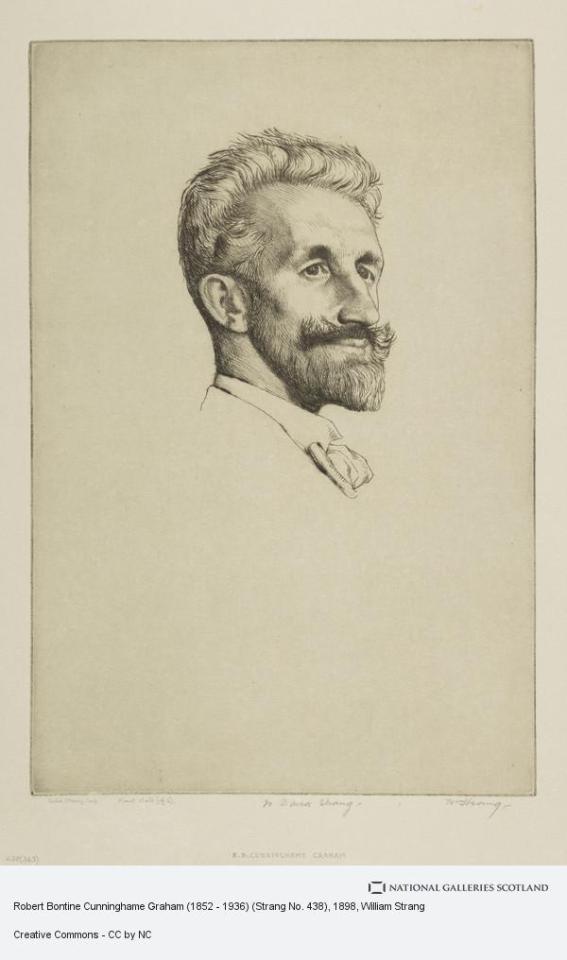
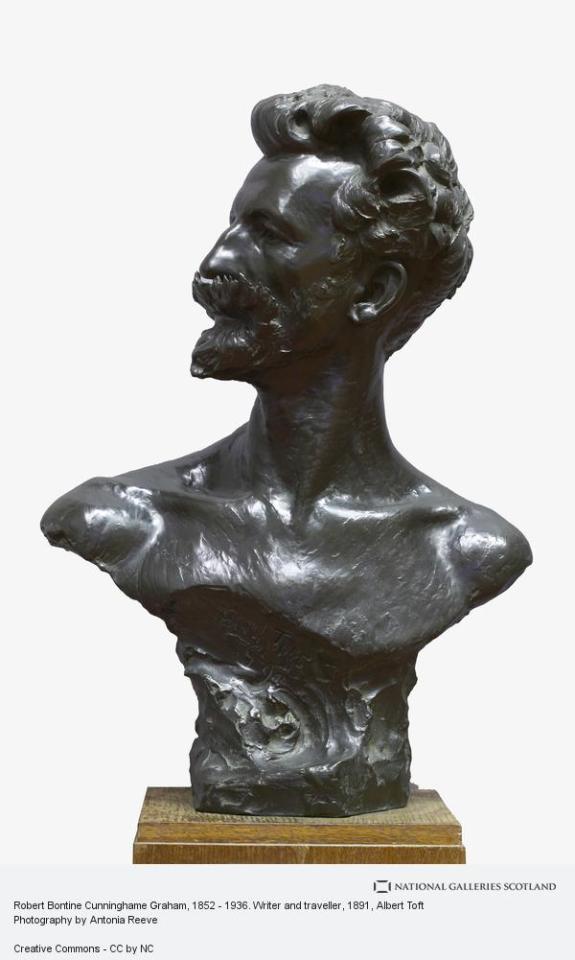


Robert Bontine Cunninghame Graham the writer, journalist, politician and adventurer. died on March 20th 1936.
There's a phrase I like, and it fits with RBCG, as I will refer him as for the rest of this post;
"I like the cut of his jib" Hang on to your hats!!
This man's life by any measure became an incredible journey starting essentially as a cowboy, then general adventurer, a politician
His schooling began at Hillhouse in Leamington Spa from 1863 to 1865 followed by two years at Harrow. His education continued in London and Brussels before he went to the Argentine in 1869/70
Why the Argentine? The answer probably lies with his mother Anne Elizabeth who was half Spanish, her mother being Dona Catalina Paulina Alessandro de Jiminez who married her father in Cadiz in 1816. She was apparently aged 16, he was 42 years old. Another connection to South America may have been that RBCG’s mother had been born on board her father’s flagship HMS Barnham in 1828, whilst it was off-shore from Venezuela. At any rate he was brought up heavily influenced by his Spanish grandmother, speaking Spanish fluently from a very early age, and in general having, for the time, an unconventional upbringing.
One other, perhaps more pressing reason, was that his father’s illness had resulted in significant debts for the family, hence, as the eldest son, he would feel an obligation to deal with those debts. It was during this time in the Argentine where he rode with gauchos, dealt in cattle and horses, for which he had an abiding passion, that he became known as Don Roberto. Unfortunately whatever he did in South America had no effect on the debt situation at home and only served to create debt of his own. One clear benefit however was his experiences there were the basis of a number stories he wrote in later life detailing the turbulent every-day life with the gauchos and the physical expansiveness of their country. He returned to Britain around 1877 however he was to go back to South America in later life on a number of occasions, one specific stay was in Uruguay where he purchased horses for the British army during World War
He lived in Paris for a while which is where he met his future wife Gabriela de la Balmondiere, apparently half French, half Chilean, marrying her there around 1878. However that was an entirely assumed name, more of which later.
His political career began in the General Election of 1885 when he stood as a Liberal candidate in North-West Lanarkshire. He lost to his Conservative opponent John Baird by over a thousand votes. In July of the following year, again as a Liberal, he stood against the same opponent and won by 332 votes. However he clearly identified as a radical socialist throughout his political career being described as the first socialist elected to parliament. He condemned a whole series of injustices of the society of the day. He was anti-imperialism, anti-racism, against child labour and was for abolishing the House of Lords, a man way ahead of his time, what we would give for a man like this in power nowadays !e was also vigorously against the profiteering he saw in property and industry which was to the detriment of the people making the profit, that is, the workforce. Considering his ancestry and family background these were astonishing views to have held but by all accounts not out of character.
His maiden speech in the House of Commons included the following words:
‘ the society in which one man works and enjoys the fruit – the society in which capital and luxury make Heaven for thirty thousand and a Hell for thirty million, that society…. with its want and destitution, its degradation, its prostitution and its glaring social inequalities – the society we call London….’
In 1887 the threat of disorder was such that demonstrations were forbidden. That did not stop a rally in Trafalgar Square against unemployment which ended in a riot. Among the leaders of the rally were RBCG and fellow socialist John Burns. Police and the army were in attendance which resulted in violence with over seventy people seriously injured and over four hundred arrests. RBCG and Burns were both severely beaten, arrested and eventually each sentenced to six weeks in Pentonville jail.
Throughout his time in Parliament (until 1892) he continued to espouse his socialist views clearly and emphatically. On one occasion at the end of his speech he said:
‘To sum up the position briefly. Failure of civilisation to humanise; failure of commercialism to procure a subsistence; failure of religion to console; failure of our parliament to intervene; failure of individual effort to help; failure of our whole social system.’
By this time Westminster had seen, and heard enough of RBCG and he was expelled from Parliament'
Around 1888 he left the Liberal party and along with Keir Hardy formed the Scottish Labour party, RBCG becoming its first president, Hardy its first secretary general. In 1892 they both stood for election as party candidates, Hardy was successful in West Ham, London however RBCG lost in the Camlachie constituency in Glasgow, thus ending his parliamentary career.
That setback did not change his political views, which even led him to criticise Labour MPs for not presenting a radical challenge to the government. He had always advocated home rule for Scotland becoming president of the Scottish Home Rule Association and in 1928 president of the newly formed National Party of Scotland. Six years later the Scottish National Party was created when the National Party joined with the Scottish Party, RBCG being appointed president of the new organisation, this was the forerunner to the SNP.
Being freed of his formal involvement with politics allowed him and his wife to travel more often. He also wrote prolifically about his travels, his politics and his concerns about the disappearance of local cultures and ways of life he had experienced in his travels. He had a large number of friends and acquaintances from all walks of life, including George Bernard Shaw, Oscar Wilde, artist John Lavery who painted portraits of him and his wife, Whistler, Epstein and Augustus John. From his early visits to South America his writings refer to gauchos he befriended in particular Exaltacion Medina and Raimundo Barragan. He had also become friendly with the author Joseph Conrad from about 1897 with the writer in a letter to RBCG commenting on his wide experiences and the people he had met by saying:
‘What don’t you know? From the outside of a sail to the inside of a prison!’
In 1900 due to the level of debt, including death duties, he was forced to sell his Gartmore estate to Sir Charles Cayzer, a cause of great disappointment and sorrow to him.
More was to follow with the death of his wife in 1906 in France. Her true name was Carrie or Caroline Horsefall born in 1858 to a Yorkshire surgeon. Why she chose her assumed name is not clear however it seems she was rebelling against her strict upbringing and took herself to Paris which may have been the reason. Another, perhaps the more plausible, is that she assumed her chosen name on her marriage to RBCG to be more acceptable to his social circle. Presumably close family members knew of the deception but that is not clear.
She was an accomplished writer contributing to The Yellow Book and writing, amongst others a life of St Teresa of Avila, had artistic and musical skills, and wrote poetry.
She died on the 8th September at Hendaye in France, her name registered as Gabriela Chideock (where did that come from?) Cunninghame Grahame.[As she had wished she was interred in the Inchmahome Priory on the Lake of Menteith, I would say this was down to RBCG as they don't just let anyone be interred there.
RBCG’s writings covered over thirty books which included 200 short stories and sketches. He also wrote Doughty Deeds a history of his great great grandfather Robert Cunninghame Graham. As may be expected during his life-time he had a very good reputation as a writer, his writings often being full of exotic individuals and adventure in faraway places. That has not fared very well since his death. A number of his stories also indicated the sadness he felt about the changes that occurred in some of the places he had visited such as the Pampas. His political reputation was also well established, particularly in the labour and Scottish Independence movements although with his privileged background it may have seemed strange but welcome to some and perhaps traitorous, to his class, to others. Again as for his writings his political activity is not well remembered today.
He had one other passion and that was horses. He owned several throughout his life but his favourite was Pampa, an Argentinian stallion he saw pulling a tram-car in Glasgow. He bought it from the tram company and rode it at every opportunity until it died in 1911.
When he went to buy horses for the British Army in Uruguay during the Great War he had two opposing emotions. He was happy to be riding again in the Pampas, but was saddened to think of their likely fate in Flanders. He wrote a book about his experience in Uruguay entitled ‘Bopicua’. The book ends with the words, to the horses, ‘eat well there is no grass like that of La Pileta , to where you go across the sea. The grass in Europe all must smell of blood’.
His made one last trip to Argentina in 1936, dying there in the Plaza Hotel in Buenos Aries on this day that year.
He lay in state in the Casa del Teatro his strong affinity with the country being recognised by the attendance of the Argentinian President at his funeral. His body was subsequently returned home and buried beside his wife in the Inchmahome Priory.The last of the family estates, Ardoch, was inherited by his brother Charles’ son Angus.
8 notes
·
View notes
Note
i like to think johnoscar been together since like immediately post-college. they've deffo got that "been together forever" vibe. the way they argue is soooo middle-aged married couple. i think if they'd only been together a little while, oscar wouldn't have allowed john to meet his mother. with all his paranoia, he seems the sort to be like "we've been together a decade, maybe i'll let you be seen in public walking on the same side of the street as me, as a treat".
i love that you sent me this ask. thank you <3
i feel like in my general mental timeline they are both rich guys whose immediately post-college obligations are "tour europe" and "work for my dad" and that they must have made it a couple of years in that vein. like oscar obviously did at least the "work for my dad" part and never thought not to like that is demonstrably what he did it is possible he did not even go to college and/or did not finish college as that was not uncommon among the "work for my dad" cohort across social classes [that had college available to them as a choice]. but i personally think oscar was in the bracket that would have at least gone for a year or two, age wise, because i estimate him being of Entry To College age prior to 1870 but after 1865, at which point it was way more common to send your sons to college regardless of whether or not he was entering the family business, and if oscar were college age prior to that then. well. i would have to seriously reevaluate my perception of him to say the least. but john.
my god john.
the thing. is that. Realistically. a guy named john adams who is the great grandson of quincy adams and a member of the adams american political family. is graduating from harvard specifically and then going to europe or farther and then going to law school and/or apprenticing in a family law firm. you can play adams family bingo with these criteria and you will get a bingo because this happened like ten times with ten guys. you will get slightly fewer bingos if you add "had some kind of crisis and/or epiphany and/or political election that prevented them from continuing to pursue law as a lawyer" but you will still probably come close.
so. i don't know anything about john EXCEPT that i think john adams, beloved by every woman in new york apparently including aurora "oh, mr. adams! how nice!" fane, would have met agnes van rhijn sooner or later regardless of anything oscar did or said, and that oscar would recognize this and either:
try to get ahead of it by being first, like, hi mom look who i met. he is the great grandson of quincy adams. and then john has to get grilled by agnes and then he has to smile politely and say he agrees with agnes's positive takes about her dad's whig political opinions.
OR. just let that introduction happen without engineering it, and then when his mother inevitably is like guess who i met. he is the great grandson of quincy adams. he can be like oh that guy? yeah that guy's nice we go to lunch sometimes. and she can be like invite him for lunch here. and then oscar will have to do that.
it is of course also possible that agnes met john before oscar did.
i ALSO think it has been shown that people are generally aware of their friendship?? like. in 1.08 they are lunching in public at, the credits confirm (props 2 tumblr user @whartonists for catching this one), the union, which is about as publicly associated as they can get, socially in the male sphere at least. and i am VERY CURIOUS to know if oscar is going to allow public associations like this to continue now that john has confirmed he cannot be trusted to not be crazy in them.
#johnoscar tag#they are so completely entirely entwined in the social community around them as independent actors in addition to as a unit#albeit a friendship unit. but still a unit.#and one that perhaps people would notice if it fell apart.
10 notes
·
View notes